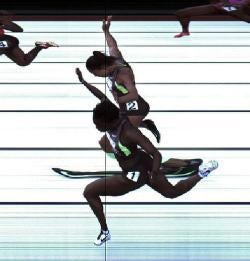An unusual thing happened Saturday evening at the Olympic trials in Eugene, Oregon. During the women’s 100-meter race, sprinters Allyson Felix and Jeneba Tarmoh tied for third. The finish was so close that images taken with a high-speed camera couldn’t tell who was faster. And it was imperative that there not be a tie: The third-place finisher was to take the last spot to run the event for the U.S. team at this summer’s London Olympics.
A tie is such a rare occurrence in the sport that USA Track and Field, the sport’s governing body, had no rule established to decide a winner. So they invented one. There will be either a coin flip or a runoff (that is, another race, between just those two runners), and the two athletes get to decide which. If they disagree, then there will be a runoff. If both athletes decline to choose either option, there will be a coin toss. And it must be decided by Sunday, when the Olympic trials end.
What’s a runner to do?
Bobby Kersee, who coaches both Felix and Tarmoh, is in favor of a runoff. “Would you go to the Super Bowl and after two overtimes or what have you, have the referees take both coaches to the middle of the field and say, We’re going to flip to see who wins the Super Bowl?” he said to the Associated Press. “I don’t see that.”
He’s right. A true sports fan should settle for nothing less than a do-over. Ties are for soccer. On the other hand, there are obvious downsides to running another race, mainly the risk of an Olympic-sidelining injury. Then again, if you’re one of the runners, and you ask for a coin toss, are you basically admitting that you’re probably the slower runner?
Brow Beat consulted Jordan Ellenberg, a professor of math at the University of Wisconsin, Madison, and Slate contributor, for strategic guidance. Before contacting Ellenberg, we reasoned that the situation might be similar to “The Prisoner’s Dilemma,” a math problem in which two conspiring criminals are faced with staying mum or ratting each other out to avoid a long jail sentence. In that case, regardless of what your fellow inmate does, making the selfish choice (ratting out your friend) is best. Perhaps the strategy the athletes should take to solve this “runner’s dilemma” is similarly simple. Perhaps not.
“There’s no way to tell if this is like the prisoner’s dilemma,” Ellenberg said. “We don’t know which solution the runners prefer.” Even so, he agreed with us on some strategies. If the other runner says run, you should agree—why look like a wimp when you’ll have to run anyways? But if the other runner wants to flip, unless you are really confident that you’ll win a second race, it makes sense to take the toss to avoid the added injury risk. A runoff, Ellenberg added, might have different conditions than the first race that favor one runner over the other. “They should just admit that it’s a chance process and flip a coin,” he said. “People want an answer.”
Optimal solution or not, USA Track and Field certainly agrees on that last point. Their new tie-breaking guidelines leave nothing to chance. (The coin-flip instructions detail the precise required positioning of the official’s fingers before the coin—a U.S. quarter dollar, Washington on one side, the eagle on the other—is tossed.) And what if the athletes pick a runoff and that race ends in a tie? Well, then it’s just an automatic flip, no runner’s dilemma to be had.
The decision—coin flip or runoff—will most likely come by Friday. Bobby Kersee advised his athletes to not make a choice until they both compete in Thursday’s 200-meter race. Let’s hope they don’t tie.
